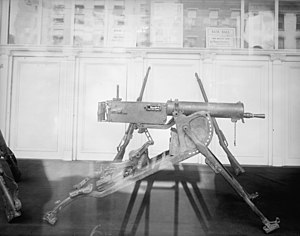MG08
| Maschinengewehr 08 | |
|---|---|

MG 08 on a sledge mount with muzzle booster fitted
|
|
| Type | Heavy machine gun |
| Place of origin | German Empire |
| Service history | |
| In service | 1908–1945 (Germany) 1911–1960s (China) |
| Used by | See Users |
| Wars |
Xinhai Revolution World War I Finnish Civil War Polish–Soviet War Chinese Civil War World War II Second Sino-Japanese War Korean War First Indochina War Vietnam War |
| Production history | |
| Manufacturer |
Deutsche Waffen und Munitionsfabriken (DWM) Spandau and Erfurt arsenals Hanyang Arsenal |
| Number built | 173,000+ |
| Variants | lMG 08 (aircraft) MG 08/15 (lightened,infantry) LMG 08/15 (aircraft) HMG Type 24 (infantry,Chinese variant) |
| Specifications | |
| Weight | Total 69 kg (152.1 lb) with water, 65 kg (143.3 lb) without water 26.5 kg (58.4 lb) gun body, 4 kg (8.8 lb) of water, 38.5 kg (84.9 lb) tripod |
| Length | 1,175 mm (46.3 in) |
| Barrel length | 721 mm (28.4 in) |
| Crew | four man crew |
|
|
|
| Cartridge |
8×57mm IS 7.65×53mm 13×92mm TuF (TuF variant) |
| Action | Short recoil, Toggle locked |
| Rate of fire | 500-600 rounds/min |
| Muzzle velocity | 900 m/s (2,953 ft/s) |
| Effective firing range | 2,000 m (2,187 yd) |
| Maximum firing range | 3,500 m (3,828 yd) |
| Feed system | 250-round fabric belt 500-round fabric belt (aircraft) |
The Maschinengewehr 08, or MG 08, was the German Army's standard machine gun in World War I and is an adaptation of Hiram S. Maxim's original 1884 Maxim gun. It was produced in a number of variants during the war. The MG 08 served during World War II as a heavy machine gun in many German infantry divisions, although by the end of the war it had mostly been relegated to second-rate fortress units.
The Maschinengewehr 08 (or MG 08)—so-named after 1908, its year of adoption—was a development of the license made Maschinengewehr 01. The firing rate depends on the lock assembly used and averages 500 rounds per minute for the Schloss 08 and 600 rounds per minute for the Schloss 16. The gun used 250-round fabric belts of 7.92×57mm ammunition, although sustained firing would lead to overheating; it was water-cooled, using a jacket around the barrel that held approximately one gallon of water. Using a separate attachment sight with range calculator for indirect fire, the MG 08 could be operated from cover. Additional telescopic sights were also developed and used in quantity during the war.
The MG 08, like the Maxim gun, operated on the basis of short barrel recoil and a toggle lock; once cocked and fired the MG 08 would continue firing rounds until the trigger was released (or until all available ammunition was expended). Its practical range was estimated at some 2,000 metres (2,200 yd) up to an extreme range of 3,600 metres (3,900 yd). The MG 08 was mounted on a sled mount (German: Schlittenlafette) that was ferried between locations either on carts or else carried above men's shoulders in the manner of a stretcher.
Pre-war production was by Deutsche Waffen und Munitionsfabriken (DWM) in Berlin and by the government Spandau arsenal (so the gun was often referred to as a Spandau MG 08). When the war began in August 1914, approximately 12,000 MG 08s were available to battlefield units; production, at numerous factories, was however markedly ramped up during wartime. In 1914, some 200 MG 08s were produced each month; by 1916—once the weapon had established itself as the pre-eminent defensive battlefield weapon—the number had increased to 3,000; and a year later to 14,400 per month.
...
Wikipedia
